From improving employee engagement and increasing knowledge of markets to higher revenues, the benefits of a diverse and inclusive workplace culture have been well-documented. Unfortunately, so has the lack of progress on this front, in spite of the millions of dollars spent on diversity initiatives. Google, for example, spent $114 million in 2014 and $150 million in 2015 on such initiatives. Their 2019 diversity report, however, revealed that Black workers still made up only 2% of its tech workforce.
"Diversity and inclusion initiatives in the contingent workforce industry have been slow to make an impact in the past because they have been too focused on spending with diverse suppliers, or worse, public relations. To drive real change, investments must go to initiatives that create inclusivity and diversity within the actual workforce," says Jim Burke, CEO of global workforce management company Workforce Logiq. "It's time to up our game."
Continue Reading for Free
Register and gain access to:
- Breaking benefits news and analysis, on-site and via our newsletters and custom alerts
- Educational webcasts, white papers, and ebooks from industry thought leaders
- Critical converage of the property casualty insurance and financial advisory markets on our other ALM sites, PropertyCasualty360 and ThinkAdvisor
Already have an account? Sign In Now
© 2024 ALM Global, LLC, All Rights Reserved. Request academic re-use from www.copyright.com. All other uses, submit a request to [email protected]. For more information visit Asset & Logo Licensing.








